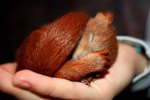Things You'll Need
Box
Towel
Heating pad
Kitten milk replacer
Acidophilus capsules
Container of cream
Eye dropper or syringe
Cotton balls
Caring for abandoned bunnies can be a daunting task. Knowing the type of bed you should make your bunny and what kind of food the baby bunny should eat is important because doing both of these properly will increase the newborn's chances of surviving without its mother. If this is a wild baby bunny that you are caring for, try to get in touch with a local wildlife rehabilitation center, which can care for the bunny and reintroduce it to the wild. If this is not an option, nurse the babies yourself with the following steps, and then release the wild bunnies when they are 5 inches in body length, urinating and defecating without problems, and eating hay and greens and plenty of water.
Making Your Abandoned Bunnies a Bed
Take a spare box you have laying around the house and fold a towel to place at the bottom. Place another towel on top of it so the bunnies can snuggle with the towel and keep warm.
Put a thin blanket over the box to make it dark. Fold back a corner so that there is about an inch open for the babies to get fresh oxygen.
Place the box in a quiet room where there is not a lot of activity. You want the babies to be able to rest and stay calm. Loud noises and rambunctious children are not a way to keep the baby bunnies calm.
Keep the room where the box is located between 68 and 72 degrees. If the room temperature is lower than that, you can place a heating pad on the low setting underneath the bottom blanket. Make sure that you only place the heating pad in one half of the box. This way, if the bunnies get too hot they can move to the side of the box without the heating pad.
Feeding Your Newborn Bunnies
Buy kitten milk replacer from a local pet store or veterinarian. Also buy acidophilus capsules from your local health food store. Make sure to buy the capsules that have the grainy filling rather than the powder because it is easier to mix. One capsule of acidophilus is equal to 1 cc. You will need this for measurements. You will also need a container of cream to mix with the kitten milk replacer to make it more caloric.
Mix together your three ingredients according to the following measurements. For newborn bunnies, mix together 5 cc of the kitten milk, ½ cc of acidophilus, and 1 tablespoon of cream for each bunny. For bunnies that are 1 week old, mix together 10-15 cc of kitten milk, ½ cc of acidophilus, and 1 tablespoon of cream. Bunnies that are 2 weeks old need a mix of 26-30 cc of kitten milk, 1 cc of acidophilus, and 1 tablespoon of cream. You will start weaning your bunnies at 4 weeks of age, so from 3 to 4 weeks of age you need to feed each of your bunnies 30 cc of kitten milk, 1 cc of acidophilus, and 1 tablespoon of cream. At 10 days, when the babies' eyes have opened, you can slowly introduce hay and pallets to them. Do not give up giving them the mixture until after 4 weeks and you know that the bunnies are eating the pallets and hay without problems.
Feed your bunnies no more than twice a day. In the wild, baby rabbits will usually feed only once a day. Since the milk you will be feeding the rabbits is not as caloric as mama’s milk, you need to feed them more often. If each bunny does not consume the whole mixture in the measurements above, it is fine to save it for later or break it up and feed half to a baby in the morning and half in the evening. Overfeeding is common in domestic rabbits and is also the No. 1 killer, so be careful to not force feed or overfeed.
Hold the baby in a loosely wrapped soft cloth or hand towel while feeding it. Keep the bunny on its back while you feed it with an eye dropper or syringe. Make sure to let the baby eat at its own pace and not force the liquid too quickly because it can cause liquid to get into the bunny's lungs and cause it to suffocate. Just be patient and let the bunny go at its own pace. Make sure to wipe away excess milk on the baby’s mouth.
Make your bunny urinate and defecate after eating. This is so important because it will keep the urinary system and intestinal tract running smoothly. You are basically doing the same act that the mother would do, just in a slightly different way. Moisten a cotton ball or soft cloth with warm water and gently stroke from between your bunny’s two front legs down to over the anal area. Do this until your bunny produces stool and urine and continue to do so until it stops. The waste may be different shades of green and yellow, so don’t be alarmed if it looks odd.
Warnings
If you notice that your bunnies appear sick, or if you have any questions on the health of your baby bunnies, contact a veterinarian immediately.
References
Photo Credits
-
Digital Vision/Photodisc/Getty Images





